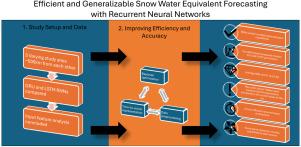亚北极和北极地区雪水当量预报:高效递归神经网络方法
IF 4.6
2区 环境科学与生态学
Q1 COMPUTER SCIENCE, INTERDISCIPLINARY APPLICATIONS
引用次数: 0
摘要
雪水当量(SWE)表示雪堆中液态水的量。准确的SWE预报对于可靠的水文建模至关重要,因为直接测量SWE是一项劳动密集型工作。在本研究中,我们系统地比较了门控循环单元(GRU)和长短期记忆(LSTM)体系结构,表明GRU模型具有相当的精度和更高的计算效率。通过应用贝叶斯优化、数据预处理和时间特征的时间向量表示,我们引入了两种新的基于gru的模型:轻量级模型(321个参数,平均NSE = 0.91)和更复杂的模型(51973个参数,平均NSE = 0.95)。重要的是,这些模型有效地推广了地理上遥远的站点,在不同的气候条件下展示了强大的预测性能。我们研究的主要新颖之处在于,在SWE预测中,GRU是一种计算效率高、准确的LSTM替代方案,同时证明了具有较小隐藏状态的紧凑模型提供了强大的空间泛化和出色的精度。本文章由计算机程序翻译,如有差异,请以英文原文为准。

Snow water equivalent forecasting in sub-arctic and arctic regions: Efficient recurrent neural networks approach
Snow water equivalent (SWE) expresses the amount of liquid water in the snow pack. Accurate SWE forecasts are essential for reliable hydrological modeling, as direct SWE measuring is labor-intensive. In this study, we systematically compared gated recurrent unit (GRU) and long short-term memory (LSTM) architectures, showing that GRU models achieve comparable accuracy with greater computational efficiency. By applying Bayesian optimization, data preprocessing, and a time-to-vector representation of temporal features, we introduce two novel GRU-based models: a lightweight model (321 parameters; average NSE = 0.91) and a more complex model (51973 parameters, average NSE = 0.95). Importantly, these models generalize effectively across geographically distant stations, demonstrating robust predictive performance under varied climatic conditions. The primary novelty of our study is identifying GRU as a computationally efficient, accurate alternative to LSTM in SWE forecasting, combined with demonstrating that compact models with smaller hidden states provide strong spatial generalization and excellent accuracy.
求助全文
通过发布文献求助,成功后即可免费获取论文全文。
去求助
来源期刊

Environmental Modelling & Software
工程技术-工程:环境
CiteScore
9.30
自引率
8.20%
发文量
241
审稿时长
60 days
期刊介绍:
Environmental Modelling & Software publishes contributions, in the form of research articles, reviews and short communications, on recent advances in environmental modelling and/or software. The aim is to improve our capacity to represent, understand, predict or manage the behaviour of environmental systems at all practical scales, and to communicate those improvements to a wide scientific and professional audience.
 求助内容:
求助内容: 应助结果提醒方式:
应助结果提醒方式:


